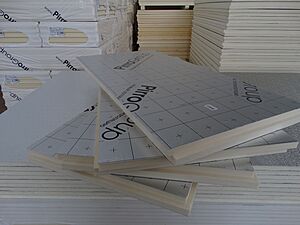Polyisocyanurate facts for kids
Polyisocyanurate, often called PIR or polyiso, is a special type of plastic. It is a thermoset plastic, which means it becomes solid and keeps its shape even when heated. PIR is usually made as a foam and is widely used as rigid thermal insulation. This helps to keep buildings warm in winter and cool in summer.
PIR is similar to another plastic called polyurethane (PUR). The main differences are in the ingredients and how they are mixed. PIR uses more of a chemical called methylene diphenyl diisocyanate (MDI) and a different type of polyol (a chemical alcohol). Also, the catalysts and additives used to make PIR are different from those used for PUR.
Uses of PIR Insulation
PIR foam is very popular for rigid thermal insulation in buildings. You might find it in several places:
- Ductwork: Thin PIR foam panels, covered with aluminium foil, are used to make pre-insulated ducts. These ducts carry air for heating, ventilation, and air conditioning systems.
- Building Walls and Roofs: Large, ready-made PIR "sandwich panels" are used for roofing and walls in big buildings like warehouses, factories, and offices. These panels have strong steel outer layers bonded to a core of PIR foam.
- Pipes and Carving: PIR foams are also used to insulate industrial pipes. Sometimes, they are even used for carving or shaping, similar to how expanded polystyrene foams are used.
When PIR panels are installed, it is important to make sure they fit together tightly. If there are small gaps, the insulation might not work as well. Using multiple layers or special interlocking joints helps to prevent these gaps.
Health and Safety
Working with PIR insulation, like cutting it, can create dust. This dust might cause temporary irritation to your skin, eyes, or nose. However, studies have not found any long-term health risks like breathing problems from PIR dust.
Fire Safety
PIR is often described as being fire retardant. This means it can resist fire to some extent. However, it is important to know that results from small tests do not always show what happens in a real fire.
Scientists study how different insulation materials behave in fires. They look at how much smoke and toxic gases are released. Most fire deaths happen because people breathe in harmful products from fires. Studies have shown that PIR can release more toxic products than some other insulating materials during a fire. For example, hydrogen cyanide is a harmful gas that can be released from PIR (and PUR) foams during a fire.
Even with this, PIR insulation is generally considered to be more resistant to fire than PUR insulation.


